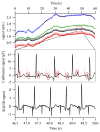Optical magnetometer array for fetal magnetocardiography
- PMID: 22739870
- PMCID: PMC3386557
- DOI: 10.1364/OL.37.002247
Optical magnetometer array for fetal magnetocardiography
Abstract
We describe an array of spin-exchange-relaxation-free optical magnetometers designed for detection of fetal magnetocardiography (fMCG). The individual magnetometers are configured with a small volume with intense optical pumping, surrounded by a large pump-free region. Spin-polarized atoms that diffuse out of the optical pumping region precess in the ambient magnetic field and are detected by a probe laser. Four such magnetometers, at the corners of a 7 cm square, are configured for gradiometry by feeding back the output of one magnetometer to a field coil to null uniform magnetic field noise at frequencies up to 200 Hz. We present the first measurements of fMCG signals using an atomic magnetometer.
Figures




References
-
- Kominis IK, Kornack TW, Allred JC, Romalis MV. Nature. 2003;422:596. - PubMed
-
- Happer W, Tam AC. Phys Rev A. 1977;16:1877.
-
- Xia H, Baranga ABA, Hoffman D, Romalis MV. Appl Phys Lett. 2006;89:211104.
-
- Johnson CN, Schwindt P, Weisend M. Appl Phys Lett. 2010;97:243703.
-
- Knappe S, Sander TH, Kosch O, Wiekhorst F, Kitching J, Trahms L. Appl Phys Lett. 2010;97:133703.
Publication types
MeSH terms
Grants and funding
LinkOut - more resources
Full Text Sources
Other Literature Sources

